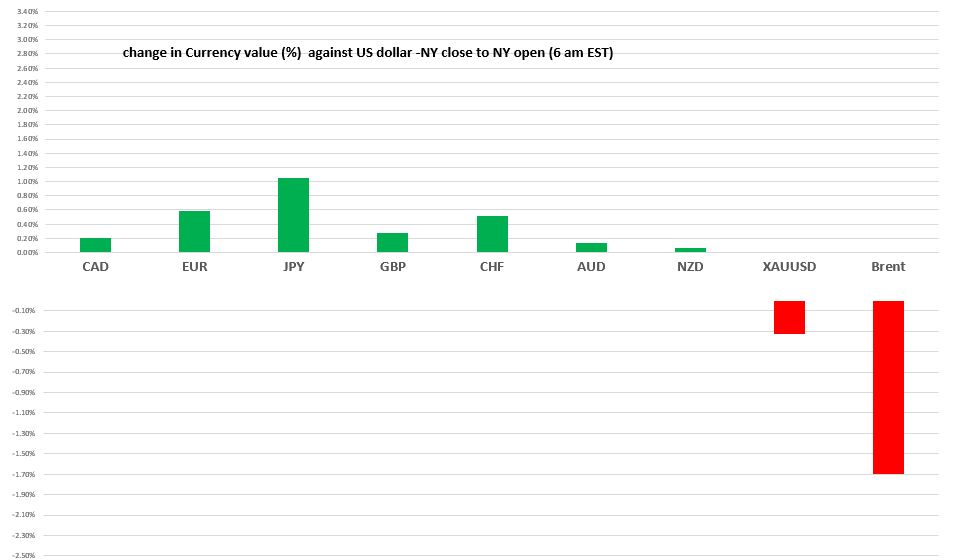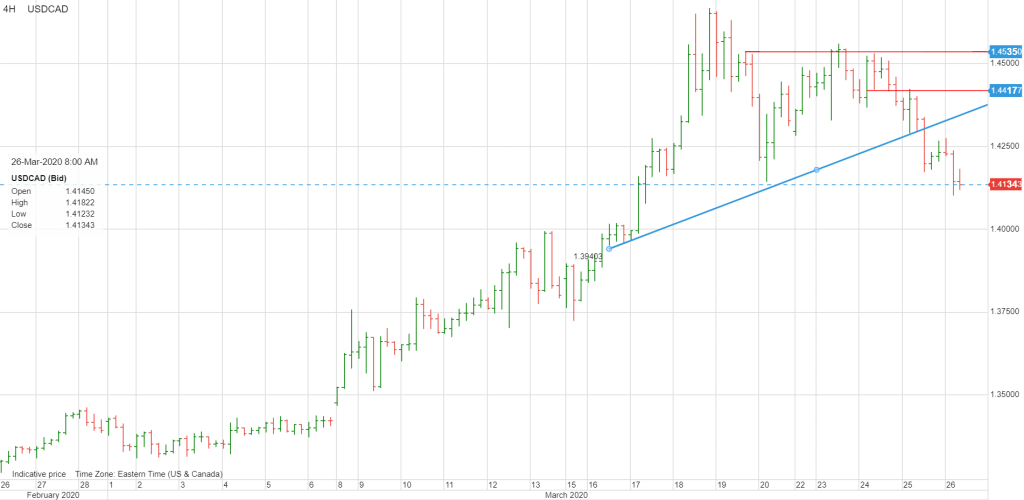
March 26, 2020
USDCAD open (6:00 am EDT) 1.4161-65 Overnight Range 1.4163-1.4275
- Weekly jobless claims data jump to 3.283 million (previous 282,000)
- G-20 holding emergency “virtual” meeting
- Bank of England policy meeting was a non-event- rates and policy left unchanged
- Global stock indices are a sea of red-US futures pointing to negative open for Wall St.
- US dollar on the defensive and adding to this week’s losses since Monday open
Chart: Currency gain/loss (%) against the US dollar from NY close to NY open (6:00 EST)

Source: Saxo Bank/IFXA
FX Recap and outlook: Economic reports were on the back burner for the past few weeks. That changed today. The weekly US Jobless Claims number blew through the 1.0 million forecast, rising 3,283,000, a new record. The number shouldn’t surprise anyone who can read, hear, or watch TV, given the sheer volume of recent lay-off announcements because of the COVID-19 outbreak. Looking forward, the weekly jobless claims data may become (for a short term), the markets preferred gauge of the health of the economy.
The other US data, including Q4 GDP, Wholesale Inventories and Goods Trade Balance, was dismissed as being stale.
Today’s G-20 “virtual” emergency meeting is hosted by Saudi Arabia, which is a tad ironic, as it was Saudi Crown Prince Mohammad bin Salam’s temper-tantrum that precipitated the oil price war and exacerbated the impact of the COVID-19 virus, globally. The G-7 already fired their big fiscal and monetary guns, which suggests the G-20 won’t have much new to offer.
EURUSD continued to rebound from last week’s 1.0650 low and broke above 1.0900 in Asia, and hit 1.0950 in early New York trading. The single currency is getting an added boost from chatter about a European Union-backed corona-bond. Nine EU countries, including France, Italy and Spain, are calling for a new debt instrument to help ease the impact of the coronavirus. Germany is vehemently opposed to such an idea. Regardless, EURUSD prices traded higher.
GBPUSD traded sideways in Asia and then rallied in Europe, with weak February Retail Sales data ignored (actual -0.3% m/m vs January’s upwardly revised 1.1%). The Bank of England left rates unchanged at 0.1%, content to wait and see the effect of their earlier actions. GBPUSD climbed from 1.1780 to 1.2000, before dipping to 1.1960 in New York.
USDJPY took it on the chin, plunging from 111.28 to 109.82 in early New York trading. Broad US dollar weakness and a drop in 10-year US Treasury yields from 0.872% to 0.795%, weighed on the currency pair.
AUDUSD and NZDUSD traded lower in during the Asia morning but recouped the losses by the New York open, due to widespread US dollar selling on improved risk appetite.
USDCAD declined in lock-step with broad US dollar selling against the G-10 major currencies, getting a modicum of support from yesterday’s WTI oil price gains. The magnitude of the fiscal and monetary actions to help combat the economic impact of COVID-19, injected a bit of positive risk sentiment into markets.
USDCAD technical outlook
USDCAD is in a downtrend while prices are below 1.4480, a level guarded by a minor downtrend line that comes into play at 1.4280. The break below 1.4190 opens the door to further losses to 1.4000. For today, support is at 1.4070 and 1.4005. Resistance is at 1.4220 and 1.4280.
Chart: USDCAD 4 hour

Source: Saxo Bank





